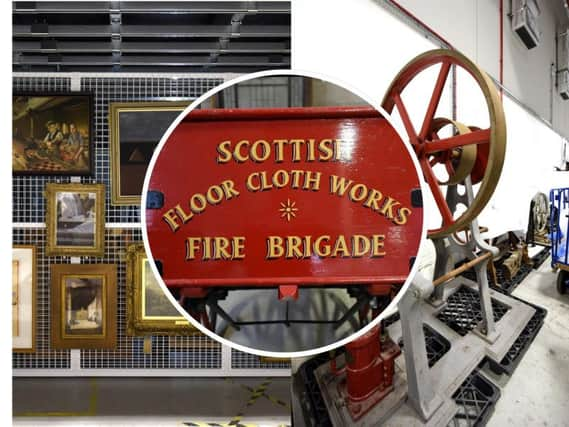Fife Council has a new archive centre - and here's an exclusive look at some of the amazing artefacts


Now, after almost 18 months of meticulous planning, packing, unloading and cataloguing of around 120,000 historical objects, documents, photographs and even a 19th century horse-drawn fire engine, they have been brought under one roof for the very first time.
The collection, comprising of virtually all of Fife museum’s stock not currently on display, along with the council’s vast archive of documents – the oldest of which date back to the 15th century – are now housed in a purpose built storage area within the local authority’s vast depot complex at Bankhead in Glenrothes.
Advertisement
Hide AdAdvertisement
Hide Ad“It’s been a long time coming and has taken a huge effort to get the 6000 boxes of museum stock from six storage areas across Fife here, but we’ve managed it and it’s fantastic to have it all in one place at last,” Gavin Grant, Fife Cultural Trust’s museum curator explains.
“This new facility provides us with the most-up-to-date technology in which to preserve, what in effect, is Fife’s cultural and historical heritage.”
With temperature controlled areas, for some of the more fragile items, as well a bespoke racking system for 1000 or so paintings and artworks not currently on display in the regions galleries, the archive is akin to an Aladdin’s cave of history in every conceivable form.
From pottery to furniture, industrial machinery to taxidermy, Scottish watercolour paintings by McTaggart and Peploe, to historic linoleum pattern book samples, there is virtually nothing the collection doesn’t have.
Advertisement
Hide AdAdvertisement
Hide Ad“It’s certainly very special and hugely satisfying to have it finally all here in one place, and while we are continuing to sort, catalogue and reassess just what we have in the collection, we are constantly receiving new items of historical importance,” Gavin, who has been based a Kirkcaldy museum and gallery since 1990, tells the Press.
The collection continues to grow with around 200 carefully considered additions being received annually.
The most significant of which in recent times was the donation earlier this year of a painting of Carnoustie Bay by renowned Scottish artist, WT McTaggart.
“Obviously while we can’t take in everything, we certainly now have a facility which better suited than ever for us to be able to preserve these little pieces of history for future generations.” Gavin adds.
Advertisement
Hide AdAdvertisement
Hide AdHowever, there are still some gaps in the council’s collection.
“We are always on the look out for significant archaeological finds, specifically items such as pilgrim badges and items of medieval importance to Fife.”
And it’s not just the museum collection that throws up interesting items,as Fife Council’s official archivist for the past 18 years, Andrew Dowsey, proves when he opens the box containing the court note book dating from 1567 detailing all of the witchcraft trials which took place in Kirkcaldy at that time.
Or how about the Protocol Book of Kirkcaldy Borough Court of 1567 which dates back to the time shortly after the Reformation, when Scotland broke ties with the Papacy to form a predominately Calvinist church.
Advertisement
Hide AdAdvertisement
Hide Ad“The book gives us an invaluble account of all the local disputes between local traders and individuals in Kirkcaldy that came before a court process,” said Andrew.
“It’s gives a snapshot of life in the region at that time and is hugely significant.”
A lot later but no less interesting are sets of architects drawings of Starks Park proposed new main stand in 1910, and of particular delight to Andrew, an map detailing the planned evacuation process for Fifers should the German army invade the Fife coastline during the Second World War.
“Officials such as police officers and others in authority were provided with the map which shows routes to be used to flee and others to be kept free for military use.
Advertisement
Hide AdAdvertisement
Hide Ad“Even more fascinating are the suggestions for civil disobedience such as driving cattle away and smashing any transport left such as bicycles, “
With the archive now fully operational, both Andrew and Gavin are keen to stress that sheer wealth of information is also available for the public to access, simply by making an appointment.
“We are here primarily to make sure the collection is preserved, but that doesn’t mean keeping it hidden away from the public under lock and key,” said Gavin.
“Recently we had a lady come in to view a specific painting that she had seen and liked many years ago but was no longer on public display.
Advertisement
Hide AdAdvertisement
Hide Ad“That’s the true value of what we have here. It belongs to the people and we are preserving it so that they can access it if they want to.”
To view a specific item, from the museum collection or documents from the Council’s archive, simply contact the department on 01592-583352 or email [email protected] to book an appointment on weekdays between 9am-1pm & 2pm-5pm.
